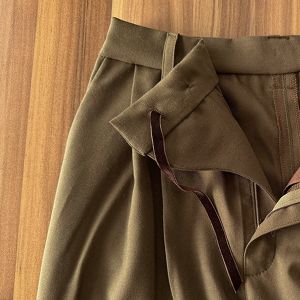About 20 years ago I learned a tailoring method of marking men’s trousers for hemming. We placed a chalk mark on the back of the trouser legs at the same point midway up the back of the leg. Then we marked the location of the finished edge of the hem. The chalk mark on the leg was supposed to help us to get the pants’ legs even, in the event that the customer had different length legs. However, I can’t remember how that influenced the amount of turn up on the pants hems. Does anyone know?
Conversational Threads
Threads Insider
Get instant access to hundreds of videos, tutorials, projects, and more.
Start Your Free TrialAlready an Insider? Log in
Conversational Threads
Highlights
-
Sign up for the Threads eletter
This site is protected by reCAPTCHA and the Google Privacy Policy and Terms of Service apply.See all newsletters -
 Sponsored Content
Sponsored Content
Where to Buy
-

-

-

-























Replies
Perhaps you are referring to the technique of marking the back of the pant leg with a l2" ruler. Because pants sometimes are very much too long and bunch up around the foot, it can be hard to mark a good hem. Instead, with the wearer in bare feet, stand the ruler on end and mark the top with a pin or chalk. Now you simply hem the pants l2" longer than the mark. I transfer the mark down with the ruler and another pin and then add the hem allowance. This works especially well with uneven legs. The pants will end up hemmed even with the bottom of the heel. If the wearer wants the pants to hang over a high heel you would simply add that much more on.
Thank you for your help. That doesn't seem exactly as I remember, but it will work for my intneded purpose. Thank you. again.
I'm not really sure what your question is, the marks at the back of the knee are there so you can line up the two pant legs to get them even (and not have to worry about lining the legs up from the crotch down, this also take car of uneven length legs)
The amount of turn up on the hem will be determined by 1) how much fabric you have to turn up 2) is there a cuff? 3) the length of the pant leg is determined by the width of the pant legs - a very narrow leg will have to be shorter - to the ankle area as it won't 'blouse' over a shoe, pants worn with high heels will be longer than pants worn with flats, and the wider the leg the longer it can be.
Thank you for your response. Please forgive me. I think I was confused writing the question because I'm confused about remembering the process. I have confused you and myself. Just forget the question I had about turn under. I know that the pant style, as well as the available fabric, determines the turn under. I'm not sure how to describe what I was asking.
I think upon reflection of your response and the other person's response, I know what to do.
We marked the line at the back of the legs, but then did we just indicate the finished hem length on one leg only and make the second the same amount of turn up? When laying the pants on the table for cuttin/hemming, I remember matching the pants legs at the mark on the back and then measuring down to the hem. I just don't remember if indicating finished point on one leg sufficed. If I measured finished point on both pants legs, then how does the mark on the pants leg in the back help, since I've already looked at both pants legs at the bottom to get them even? Again, I thank you for your help and for prodding me to be more specific.
Edited 11/14/2006 12:00 pm ET by happy2sew
Yes, you only need to mark the hem on one leg. Mark the center back, center front and each side on one leg only - if you have pinned or marked both leg hems then you don't need to place the mark at thge center back knee.Hope this helps
Thank you very much. Yes, it helps.
We used to do something like that.We marked the side seams at the 12" mark.A "regular" hem was measured 10 3/4" down from the mark, if the customer wanted less "break" on the front, it was 10 1/2" or 11" if he preferred longer. We did double-check and line up the marks before marking the hem.If you wanted to do this without scooching down, cut a yardstick off at 32", and measure 30 1/2", (30 3/4", 31") down. 32" is below most mens' hips, so if his legs are different lengths, it still works. This works on the theory that the average hem desired ends up 1 1/4" from the floor. All these were done with the gentleman wearing shoes.
This post is archived.